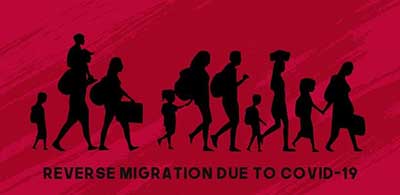Relevance: GS-3: Indian Economy and issues relating to planning, mobilization of resources, growth, development and employment; Inclusive growth and issues arising from it.
Relevance: GS-2: Issues relating to the development and management of Social Sector/Services relating to Health, Education, Human Resources.
Key phrases: Reverse migration, Tier-2 cities, Amrut, Smart cities, Rurban mission, Mindtree company, zoho, Randstad Salary Trends Report 2021
Why in News?
- Recently, it has been observed that thousands of techies have chosen to move to their home towns and villages and work from there.
- This reverse migration is due to various reasons: To stay safe from covid, get closer to their roots, escape the pressures of big-city life, spend more time with family or just to enjoy a slice of life in the hinterland.
- In many instances work productivity has actually gone up - IT companies large and small have been lining up to support techies looking to migrate from metro cities.
- New Trend Emerging:
- The tech firms are either opening centres in tier-2 cities or rural centres to support this growing workforce.
- It also helps in allowing them to work from home or through hybrid arrangements where they attend office when required.
Why are Big Tech’s hiring strategies changing and accelerating the phenomenon of voluntary reverse migration?
- Cost vs Talent:
- Today, the hiring strategy of IT firms in tier-2 cities seems to be driven more by quality than the cost of talent. Hiring more from tier-2 cities, not from a cost perspective but from a talent-reach and availability perspective.
- Phenomenon of inclusive growth and balanced development:
- Expanding presence across tier-2 and -3 cities will help companies to become more inclusive and take the benefits of growth to more people. Mid- and high-level professionals from these cities are also looking for opportunities to return to their roots.
- Energy availability is not an issue:
- Electricity may have been a challenge earlier, but today a generator or a solar installation can make a company independent of electricity needs.
- Government also incentivise the reverse migration:
- To attract more people to tier-3/4 cities, the government is also ensuring good education for the employees’ kids, as well as medical facilities.
- The schemes like Amrut, Smart cities, Rurban mission are developing needed basic amenities.
- Diversification and Expansion of company's outreach:
- Tapping into cities that offer a good talent pool and creating opportunities for broad-based, diversified growth are important aspects of the company's growth strategy.
- For example, Mindtree Company’s decision to set up offices in cities such as Coimbatore and Warangal is a part of the company’s ‘Work of the Future’ talent strategy.
- New startups also prefer smaller cities: Apart from the big tech terms, several startups based in tier-2 and -3 cities are hiring more people, indicating business growth and availability of talent in smaller cities. Moreover, their cost of operations too minimised.
- No lag in required skill and great spirit of up skilling:
- Young talent in tier-2 and -3 cities is not lagging when it comes to using digital platforms/courses to stay relevant in today’s market.
- People in these cities are eager to learn and improve, and they adjust quite quickly.
- Tier 2 and Tier 3 cities too are powerhouse of talents:
- For example, Coimbatore:
- The city and its neighbouring districts have the highest density of colleges within a 100 km radius, making it an educational hub.
- These educational institutes help hone students with the right skills required for a job, especially in the tech industry.
- For example, Coimbatore:
Case study of Zoho
- Zoho began promoting rural offices long before the pandemic, but this get accelerated in the wake of the pandemic.
- Zoho prefers to set up centres in smaller towns as well as rural
areas for two reasons:
- By bringing more and more people from smaller towns to big cities, we are uprooting them. By locating our offices closer to where people come from, it allows employees to remain rooted as well as closer to family, friends, and the community.
- Company pays the same salary in urban as well as our rural centres, which translates into more benefits for those working in rural centres.
Way Forward
- The hiring outlook for the Indian IT sector looks promising in 2022 as the country recovers from the pandemic-induced slowdown and returns to normal operational levels.
- Many IT giants like Wipro, Infosys have announced plans to hire at least 50,000 to 65,000 employees each by the end of this year and a large chunk of this talent pool is expected to come from the non-metros.
- Colleges in tier 2-3 cities are now connecting graduates to a wide variety of companies through online guest lectures and interview programmes, thereby opening avenues for companies to hire talent in remote regions.
- Importantly, working from non-metros does not necessarily mean lower
salaries and most companies pay employees on par with other locations.
- In fact, the Randstad Salary Trends Report 2021 added tier-2 cities as a category that are emerging as future talent hubs and job creation centres.
- In the recently-presented Union Budget, too, finance minister Nirmala Sitharaman alluded to promoting smaller cities alongside urban development. For this to happen, urban planning cannot continue with a business-as-usual approach. Government needs a plan to steer a paradigm change.
Source: The Hindu BL
Mains Question:
Q. “There is a need for a paradigm shift in how we view reverse migration from an urban to rural distress phenomenon to a modern business strategic idea. In this context, analyse how reverse migration emerged as Big Tech’s new strategies for cost minimisation and talent optimisation". Discuss. (15 marks)









